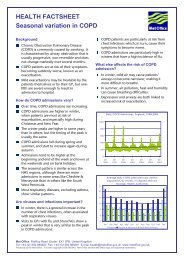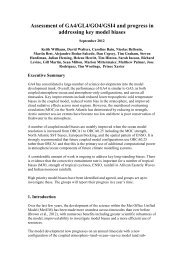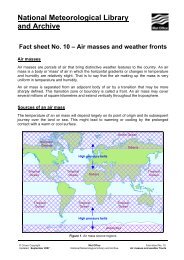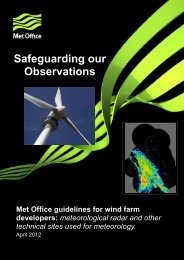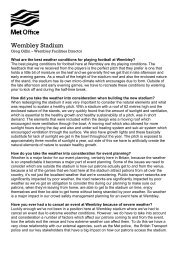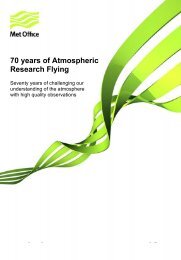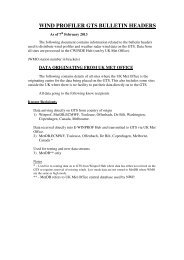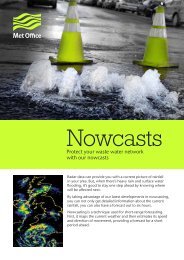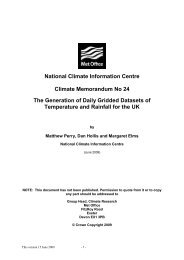Description and assessment of the OSTIA reanalysis. - Met Office
Description and assessment of the OSTIA reanalysis. - Met Office
Description and assessment of the OSTIA reanalysis. - Met Office
You also want an ePaper? Increase the reach of your titles
YUMPU automatically turns print PDFs into web optimized ePapers that Google loves.
ATSR-1 with bias correction<br />
ATSR-1 without bias correction<br />
Regions Mean (RMS) No. <strong>of</strong> obs Mean (RMS) No. <strong>of</strong> obs<br />
Global -0.24(0.84) 1589370 -0.11(0.76) 1608688<br />
North Atlantic -0.08(0.83) 244515 -0.01(0.78) 248564<br />
North Pacific -0.24(0.86 365001 -0.15(0.80) 372102<br />
South Pacific -0.29(0.76) 348601 -0.11(0.62) 349907<br />
South Atlantic -0.24(0.77) 100648 -0.08(0.68) 102118<br />
Mediterranean 0.08(0.78) 36071 0.09(0.77) 36123<br />
Arctic -0.15(1.21) 31523 -0.04(1.17) 32327<br />
Sou<strong>the</strong>rn Ocean -0.33(0.88) 162946 -0.22(0.81) 164688<br />
Indian -0.30(0.82) 273634 -0.13(0.72) 277170<br />
Table 3.3: Average regional ATSR-1 observation minus background bias(RMS) in K <strong>and</strong> no. <strong>of</strong><br />
observations for experimental runs with <strong>and</strong> without bias correcting ATSR-1 quality data to in-situ<br />
reference data<br />
<strong>the</strong> total covariance used by <strong>the</strong> assimilation scheme. The background error covariance matrix<br />
used in <strong>the</strong> <strong>OSTIA</strong> <strong>reanalysis</strong> is <strong>the</strong> same as that used in <strong>the</strong> operational <strong>OSTIA</strong> system <strong>and</strong> has<br />
been calculated using output from a 3 year hindcast <strong>of</strong> <strong>the</strong> <strong>Met</strong> <strong>Office</strong> FOAM system (Storkey<br />
et al., 2010; Bell et al., 2000) which resulted in error correlation length scales <strong>of</strong> 10km <strong>and</strong> 100km.<br />
The effective correlation scale is <strong>the</strong> sum <strong>of</strong> both components <strong>and</strong> varies spatially so that in areas <strong>of</strong><br />
high mesoscale variability <strong>the</strong> errors associated with that variability dominate, whilst in o<strong>the</strong>r regions<br />
larger spatial scale errors will dominate.<br />
The observation error covariance matrix determines <strong>the</strong> relative weight given to each observation<br />
within <strong>the</strong> assimilation. The observation errors comprise both a measurement error <strong>and</strong><br />
a representivity error. Within <strong>the</strong> <strong>OSTIA</strong> system an assumption is made that <strong>the</strong> high resolution<br />
grid implies that errors <strong>of</strong> representivity are small <strong>and</strong> measurement errors dominate. For both<br />
<strong>the</strong> AVHRR Pathfinder <strong>and</strong> (A)ATSR satellite data each observation comes with an estimate <strong>of</strong> <strong>the</strong><br />
measurement error provided by <strong>the</strong> data producers. For <strong>the</strong> AVHRR Pathfinder data <strong>the</strong>se errors<br />
are provided by <strong>the</strong> st<strong>and</strong>ard deviation <strong>of</strong> <strong>the</strong> observation values that contributed to <strong>the</strong> SST value<br />
within each particular grid box. For grid boxes with a single observation only a minimum st<strong>and</strong>ard<br />
deviation <strong>of</strong> 0.33 K is used (Kearns et al., 2000). For <strong>the</strong> (A)ATSR data this information was provided<br />
in <strong>the</strong> form <strong>of</strong> <strong>the</strong> SSES st<strong>and</strong>ard deviation (REF). These are used to form <strong>the</strong> observation error<br />
covariance matrix. For <strong>the</strong> in-situ data <strong>the</strong> observation errors vary spatially <strong>and</strong> are obtained from<br />
© c Crown Copyright 2011 33




